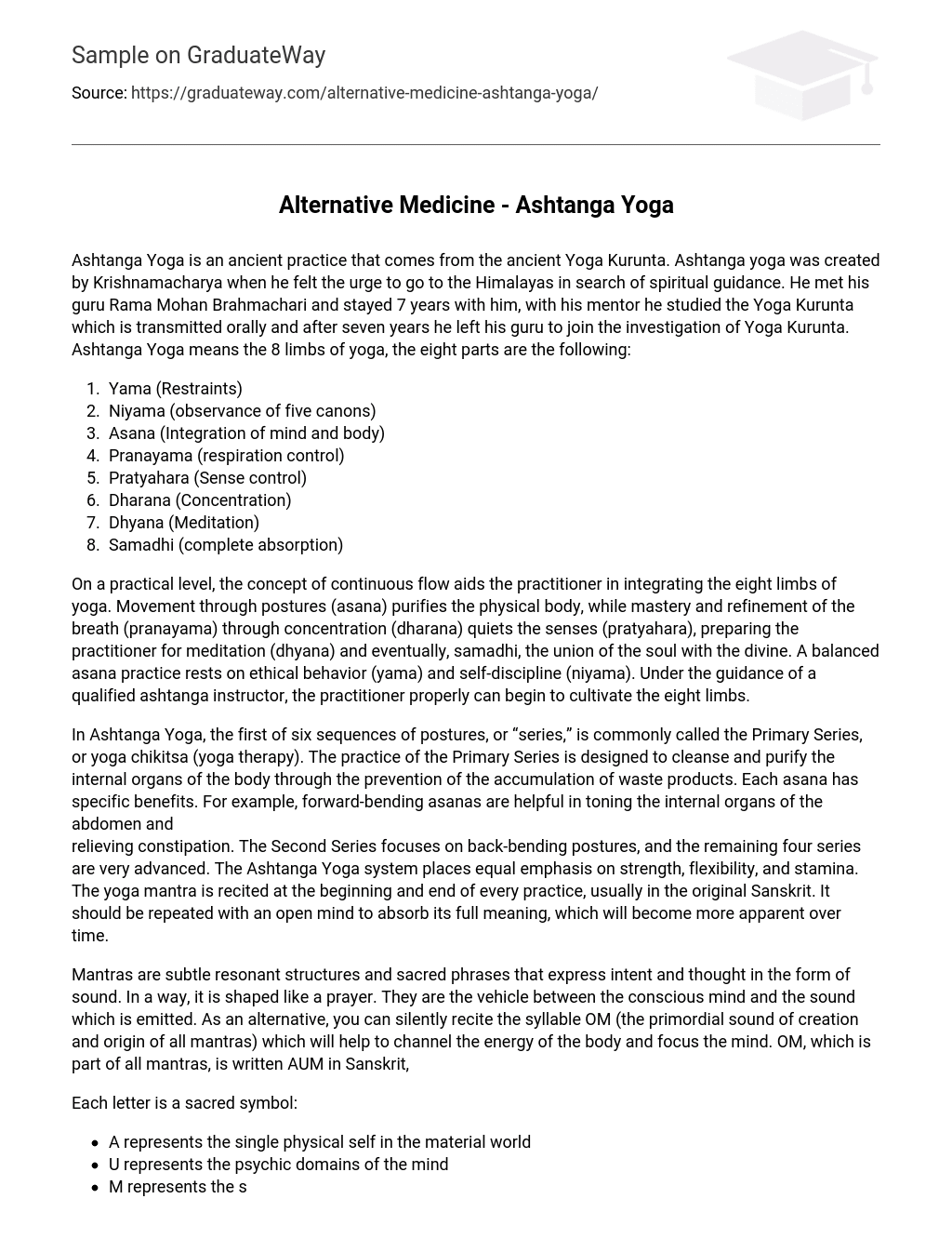Ashtanga Yoga is an ancient practice that comes from the ancient Yoga Kurunta. Ashtanga yoga was created by Krishnamacharya when he felt the urge to go to the Himalayas in search of spiritual guidance. He met his guru Rama Mohan Brahmachari and stayed 7 years with him, with his mentor he studied the Yoga Kurunta which is transmitted orally and after seven years he left his guru to join the investigation of Yoga Kurunta. Ashtanga Yoga means the 8 limbs of yoga, the eight parts are the following:
- Yama (Restraints)
- Niyama (observance of five canons)
- Asana (Integration of mind and body)
- Pranayama (respiration control)
- Pratyahara (Sense control)
- Dharana (Concentration)
- Dhyana (Meditation)
- Samadhi (complete absorption)
On a practical level, the concept of continuous flow aids the practitioner in integrating the eight limbs of yoga. Movement through postures (asana) purifies the physical body, while mastery and refinement of the breath (pranayama) through concentration (dharana) quiets the senses (pratyahara), preparing the practitioner for meditation (dhyana) and eventually, samadhi, the union of the soul with the divine. A balanced asana practice rests on ethical behavior (yama) and self-discipline (niyama). Under the guidance of a qualified ashtanga instructor, the practitioner properly can begin to cultivate the eight limbs.
In Ashtanga Yoga, the first of six sequences of postures, or “series,” is commonly called the Primary Series, or yoga chikitsa (yoga therapy). The practice of the Primary Series is designed to cleanse and purify the internal organs of the body through the prevention of the accumulation of waste products. Each asana has specific benefits. For example, forward-bending asanas are helpful in toning the internal organs of the abdomen and
relieving constipation. The Second Series focuses on back-bending postures, and the remaining four series are very advanced. The Ashtanga Yoga system places equal emphasis on strength, flexibility, and stamina. The yoga mantra is recited at the beginning and end of every practice, usually in the original Sanskrit. It should be repeated with an open mind to absorb its full meaning, which will become more apparent over time.
Mantras are subtle resonant structures and sacred phrases that express intent and thought in the form of sound. In a way, it is shaped like a prayer. They are the vehicle between the conscious mind and the sound which is emitted. As an alternative, you can silently recite the syllable OM (the primordial sound of creation and origin of all mantras) which will help to channel the energy of the body and focus the mind. OM, which is part of all mantras, is written AUM in Sanskrit,
Each letter is a sacred symbol:
- A represents the single physical self in the material world
- U represents the psychic domains of the mind
- M represents the spiritual light of the intuitive being that dwells within.
Opening Mantra
Om Vande Gurunam Charanaravinde Sandarshita Svatma Sukava Bodhe Nih Sreyase Jangalikayamane Samsara Halahala Mohashantyai Abahu Purushakaram Shankhacakrsi Dharinam Sahasra Sirasam Svetam Pranamami Patanjalim Om
om
I bow to the lotus feet of the Supreme Guru which awaken insight into the happiness of pure Being, which are the refuge, the jungle physician, which eliminate the delusion caused by the poisonous herb of Samsara (conditioned existence). I prostrate before the sage Patanjali who has thousands of radiant, whiteheads (as the divine serpent, Ananta) and who has, as far as his arms, assumed the form of a man holding a conch shell (divine sound), a
wheel (discus of light or infinite time) and a sword (discrimination). om
Finishing Mantra
Om
Svasthi Praja Bhyaha Pari Pala Yantam Nya Yena Margena Mahim Mahishaha Go Brahmanebhyaha Shubamastu Nityam Lokah Samastah Sukhino Bhavantu Om Shanti Shanti Shantihi
May the rulers of the earth keep to the path of virtue For protecting the welfare of all generations. May the religious, and all peoples be forever blessed, May all beings everywhere be happy and free
Om peace, peace, perfect peace





